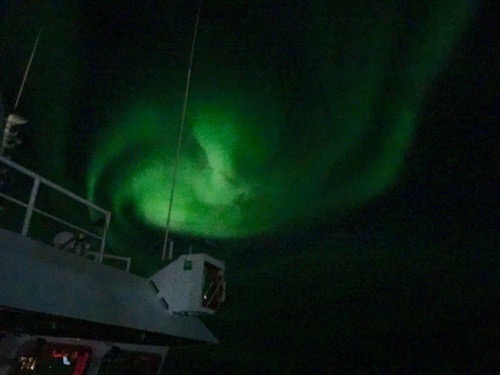"Hey there's an Aurora!"
That was all we needed to hear at about 1:30am to send us out into the dark cold night! I had stayed up late to work on our PolarTREC webinar that was coming up in a few days, and was very glad that I was already awake to see natures light show!
It's about 3am now...and I'm really ready for bed, but I just couldn't go to sleep without posting some of my photos in a journal for you all to see later today. I hope you enjoy them!
 Aurora over the Beaufort Sea onboard the R/V Sikuliaq! September 12, 2017. Photo by Lisa Seff.
Aurora over the Beaufort Sea onboard the R/V Sikuliaq! September 12, 2017. Photo by Lisa Seff.
 Aurora over the Beaufort Sea onboard the R/V Sikuliaq! September 12, 2017. Photo by Lisa Seff.
Aurora over the Beaufort Sea onboard the R/V Sikuliaq! September 12, 2017. Photo by Lisa Seff.
 Wow! How awesome is that! Aurora over the Beaufort Sea and Lisa Seff onboard the R/V Sikuliaq! September 12, 2017. Photo by Lisa Seff.
Wow! How awesome is that! Aurora over the Beaufort Sea and Lisa Seff onboard the R/V Sikuliaq! September 12, 2017. Photo by Lisa Seff.
 Aurora over the Beaufort Sea and the bridge onboard the R/V Sikuliaq! September 12, 2017. Photo by Lisa Seff.
Aurora over the Beaufort Sea and the bridge onboard the R/V Sikuliaq! September 12, 2017. Photo by Lisa Seff.
 Aurora over the Beaufort Sea and the bridge onboard the R/V Sikuliaq! September 12, 2017. Photo by Lisa Seff.
Aurora over the Beaufort Sea and the bridge onboard the R/V Sikuliaq! September 12, 2017. Photo by Lisa Seff.
 I went online to the Geophysical Institute at the University of Alaska Fairbanks and screen shot their Aurora Forecast just after going back inside! Amazing as the light show was, we were only at the edge of the forecast area. September 12, 2017. Screen shot by Lisa Seff.
I went online to the Geophysical Institute at the University of Alaska Fairbanks and screen shot their Aurora Forecast just after going back inside! Amazing as the light show was, we were only at the edge of the forecast area. September 12, 2017. Screen shot by Lisa Seff.
Why do Auroras occur? The basic explanation is that when electrons and protons from the Sun travel along Earth’s magnetic field lines that come together near both Poles, this causes those particles to collide with atoms in the atmosphere. During the collision an exchange of energy takes place that excites the atoms. When the atoms return to an unexcited state they can give off light resulting in the Aurora. For a more detailed explanation, as well as the Aurora forecast please visit the following website: http://www.gi.alaska.edu/AuroraForecast


Comments
Add new comment